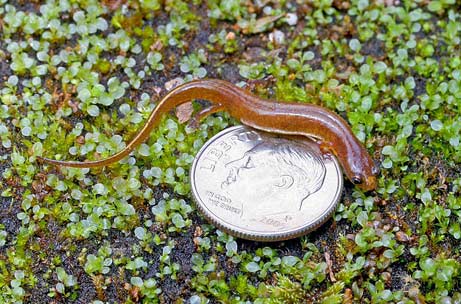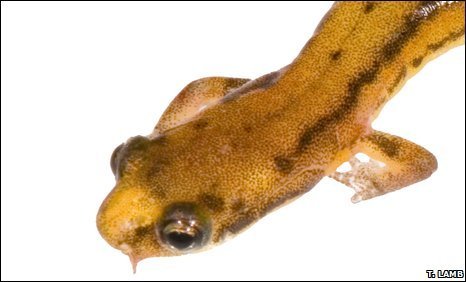
July 12, 2009
Just announced this week, the researchers who discovered the salamander describe it in the Journal of Zoology. They have dubbed it the patch-nosed salamander after the yellow patch on the animal’s snout and it is the second smallest salamander in the United States.
Scientists found the 2-inch-long (5.1-centimeter-long) amphibian (pictured above) in 2007, in a creek near a well-traveled road in northern Georgia.

“This animal is really a spectacular find,” says biologist Carlos Camp of Piedmont College in Demorest, Georgia, who led the team which described the new species. “It is the first genus of amphibian, indeed of any four-footed vertebrate, discovered in the US in nearly 50 years.”
Two graduate students, Bill Peterman of the University of Missouri, Columbia and Joe Milanovich of the University of Georgia, Athens discovered the first example of the species, scientifically named Urspelerpes brucei. They took the animal to Camp for identification, according to the BBC News and NatGeo.
A geneticist, Trip Lamb, of East Carolina University, Greenville and a bone specialist, David Wake of the University of California at Berkeley. John Maerz, a professor at the University of Georgia, completed the research team.

A yellow male with stripes above a more muted female.
Males have a pair of distinct dark stripes running down the sides of the body and a yellow back. Females lack stripes and are more muted in color.
Males also have 15 vertebrae, one less than females. Yet while most species of lungless salamander have male and females of differing sizes, those of Urspelerpes brucei are close to being equal in size.
Uniquely for such a small lungless salamander, Urspelerpes brucei has five toes, whereas most other small species have reduced that number to four.
The last previously new genus of amphibian living in the US to be described, in 1961, was also a lungless salamander, the Red Hills Salamander of southern Alabama.
About Loren Coleman
Loren Coleman is one of the world’s leading cryptozoologists, some say “the” leading living cryptozoologist. Certainly, he is acknowledged as the current living American researcher and writer who has most popularized cryptozoology in the late 20th and early 21st centuries.
Starting his fieldwork and investigations in 1960, after traveling and trekking extensively in pursuit of cryptozoological mysteries, Coleman began writing to share his experiences in 1969. An honorary member of Ivan T. Sanderson’s Society for the Investigation of the Unexplained in the 1970s, Coleman has been bestowed with similar honorary memberships of the North Idaho College Cryptozoology Club in 1983, and in subsequent years, that of the British Columbia Scientific Cryptozoology Club, CryptoSafari International, and other international organizations. He was also a Life Member and Benefactor of the International Society of Cryptozoology (now-defunct).
Loren Coleman’s daily blog, as a member of the Cryptomundo Team, served as an ongoing avenue of communication for the ever-growing body of cryptozoo news from 2005 through 2013. He returned as an infrequent contributor beginning Halloween week of 2015.
Coleman is the founder in 2003, and current director of the International Cryptozoology Museum in Portland, Maine.
Filed under CryptoZoo News, New Species